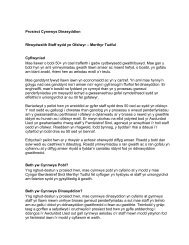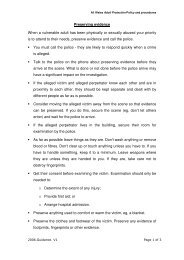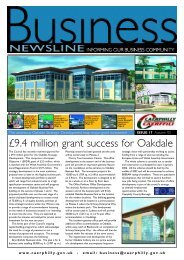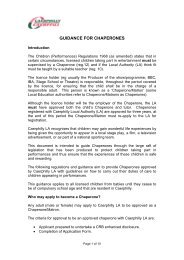A Typical Energy from Waste Process
A Typical Energy from Waste Process
A Typical Energy from Waste Process
Create successful ePaper yourself
Turn your PDF publications into a flip-book with our unique Google optimized e-Paper software.
About <strong>Energy</strong> <strong>from</strong> <strong>Waste</strong><strong>Energy</strong> <strong>from</strong> <strong>Waste</strong> (EfW) is a technology that sees post-recycling, residualwaste burned at high temperatures under carefully controlled conditions togenerate heat, steam and electricity.The process also produces Incinerator Bottom Ash (IBA), which will berecycled for use as aggregate material in the construction industry, and AirPollution Control Residue (APCR), which will be treated at a licensed facilitywhilst longer-term recycling optionsare explored.As part of its contract with Prosiect Gwyrdd, Viridor is committed torecycling 100% of the IBA <strong>from</strong> Trident Park for the most sustainablesolution and to help the authorities meet higher recycling targets.Viridor is also exploring opportunities for finding ways to re-use the APCRto maximise the recycling rate for Prosiect Gwyrddstill further.Viridor iscommitted torecycling 100%of the IBA <strong>from</strong>Trident ParkA <strong>Typical</strong> <strong>Energy</strong> <strong>from</strong><strong>Waste</strong> <strong>Process</strong>Supporting Partner
About <strong>Energy</strong> <strong>from</strong> <strong>Waste</strong> Q&AIs <strong>Energy</strong> <strong>from</strong> <strong>Waste</strong> safe?There are around 20 EfW facilities already operating in theUK and hundreds more across Europe. All the plants operateunder the <strong>Waste</strong> Incineration Directive with tight controlson emission limits and are monitored by the EnvironmentAgency.We are not aware of any peer-reviewed studiesthat conclusively link adverse health outcomes to EfWemissions. A 2004 Defra report concluded that there are “noconvincing links between EfW plant emission and adverseeffects on public health”.What is APCR and how is it captured and treated?Air Pollution Control Residue (APCR) is predominantly fly ashthat results <strong>from</strong> the combustion process, in additionto the lime and activated carbon that is used as part of the airpollution control process.The APCR is captured in filter bags and sent for safetreatment at an appropriately licensed facility. Viridor isalready looking at project to find a recycling solution forthe residues.Does Prosiect Gwyrdd have any control overthe facility?Prosiect Gwyrdd does have control over the facilitythrough a performance management framework thatenables the Partnership to monitor the day-to-dayrequirements of the contract.Environment Agency Wales will ensure that Viridor complieswith all relevant legislation and their environmental permit.These control measures will be monitored by a contractmanager on behalf of the five local authorities.Is there an environmental benefit <strong>from</strong> sending residualwaste to energy <strong>from</strong> waste compared to landfill?There is a significant environmental benefit. Buryingbiodegradable waste in landfill produces methane andmethane as a green house gas is 23 times more potent thanCarbon dioxide and is one of the main contributing factors toclimate change.A typical comparison of emissions <strong>from</strong>Viridor’s Lakeside EfW facility and trafficon a 56 mile section of the M25Tonnes emitted per year3,000.002,500.002,000.001,500.001,000.00500.00Annual actualemissions to air<strong>from</strong> Lakeside EfWAnnual actualemissions to air<strong>from</strong> the SurreySection of the M250.00Oxidesof nitrogenCarbonmonoxideFine particulatematterVolatile organiccompoundsSubstanceActual Emissions <strong>from</strong>Lakeside EfW (tonnesper annum)Permitted Emissions <strong>from</strong>Lakeside EfW (tonnesper annum)Surrey Section of the M25(tonnes per annum)Actual EfW emissions as apercentage of the SurreySection of the M25Oxides of nitrogen (NOx)3064162,98710.3%Carbon Monoxide (CO)241042,3301.0%Fine Particulate Matter (PM10)2.7321783.5%Volatile OrganicCompounds (VOCs)4213661.0%
















